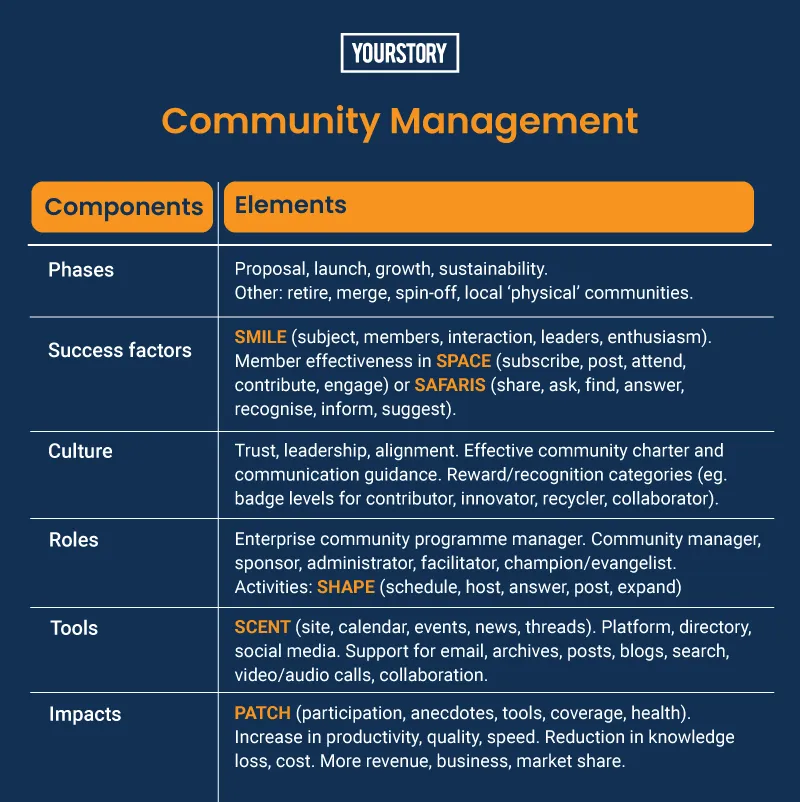Passion, culture, process: tips and frameworks for harnessing a community of practice
‘The Handbook of Community Management’ by Stan Garfield provides a wealth of tips and examples of learning communities. Here are some key takeaways and insights.
Launched in 2012, YourStory's Book Review section features over 315 titles on creativity, innovation, knowledge work, and digital transformation. See also our related columns The Turning Point, Techie Tuesdays, and Storybites.
Organisational leaders looking for a guide to implementing effective knowledge communities can find useful frameworks and case studies in the book, Handbook of Community Management: A Guide to Leading Communities of Practice, by Stan Garfield
Communities can be defined as voluntary groups that people join for personal or professional improvement, beyond what project teams or social networks offer. Communities of practice are regarded as a core foundation of knowledge management (KM).
Stan Garfield is an established KM expert and author, with wide experience at Deloitte and HP. Based in Michigan, he is the founder of the SIKM leaders community with over 800 members globally. His other books include Implementing a Successful KM Programme and Proven Practices for Promoting a KM Programme.
The 220-page book is packed with actionable advice, tips, and checklists drawn from the author’s extensive experience. There are useful figures and screenshots of community portals, along with a 20-page resource section citing 40 books and online resources.
Here are my six key clusters of takeaways from this must-have reference book, summarised as well in the table below. See also my reviews of the related books The Knowledge Manager’s Handbook, Virtual Teams across Cultures, Critical Knowledge Transfer, KNOWledge SUCCESSion, The Resilient Organisation, Navigating the Minefield, and my book series The KM Chronicles for KM case studies.
As media partner for the annual CII Global Knowledge Summit, see also YourStory’s coverage of the editions from 2021, 2020, and 2019, and sessions takeaways from the earlier Bangalore K-Community meetups on KM branding, case studies (HGS, Unisys) and Work From Home.
Check out our profiles of the Most Innovative Knowledge Enterprise (MIKE) award winners: Dubai Municipality, EY, Tata Steel, Cognizant Technology Solutions, Afcons Infrastructure, Petroleum Development Oman, and Mobarakeh Steel Company (Iran).

I. Foundations
“Communities are groups of people who share an interest, a specialty, a role, a concern, a set of problems, or a passion for a specific topic,” Stan defines.
Communities are different from teams – they are based on topics, and not specific assignments. They are also different from social networks. People join communities voluntarily, based on their interest or practice.
Communities are core to knowledge management (KM), with a combination of peer groups, digital tools, information management, intellectual capital, and organisational learning. Community engagement helps members share ideas, get answers, brainstorm, reuse knowledge, collaborate, and improve professional skills.
“Communities readily make possible Working Out Loud (WOL),” Stan explains. This combines observable work with task narratives, and spurs journaling, personal branding, and even serendipity.
He distinguishes between communities of interest (eg. hobbies) and communities of practice (CoP for work-related tasks or expertise, eg, project management, AI, recruiting).

II. Principles
Communities should have a compelling topic about which people are passionate, committed leaders, a rhythm of events, and active discussion. Questions are answered within specified times, and replies are rated and/or applied.
Community launches should be effectively promoted, with appropriate expectation setting. Valuable insights from discussions should be extracted and archived.
“Lurking is okay, because it allows those members who are new, inexperienced, or shy to learn from the more active members,” Stan clarifies. At the same time, it is important not to let a few members dominate discussions, he cautions.
“A community charter is a document that defines the scope, objectives and participants in a community,” Stan defines. Guidance should be provided on appropriate nature of posts, language, tone, and confidentiality.
The community manager should intervene to enforce these guidelines against “trolls, spammers, ranters, and bullies.” Rewards can be given as badge levels in categories like contributor, innovator, recycler, and collaborator, Stan suggests.
III. Impacts and benefits
Communities provide benefits at multiple levels – individuals, groups, and organisations. They stimulate learning, collaboration and problem solving, which can lead to faster resolution of customer concerns, business development, and reduction of knowledge loss.
Knowledge communities can help reduce redundancy, repeating mistakes, information overload, and communication delays. Generated templates lead to repeatable and scalable processes, Stan affirms.
Scarce expertise can be amplified, and the full combination of experience and organisational intelligence can lead to business growth and innovation.
Stan sums up the success measures of communities programmes via the acronym PATCH (participation, anecdotes, tools, coverage, health). Specific measures can be number of testimonials, success stories, and frequency of posts, newsletters and online/offline events.
Individuals can be rated and rewarded based on their performance against such measures. But it is important to guard against “gaming” of such metrics, Stan cautions. He led the communities programme at HP, and the HP KM Stars programme was so successful that it was adapted in other companies as well.
“One type of content that should be a priority is the success story,” Stan affirms. It should address challenges faced, resources provided by the community, and realised benefits.
“A story can translate dry, abstract numbers into compelling pictures,” Stan writes. The curated collection of “community wins” can be a powerful motivator (eg. the Twitter account @SlackLoveTweets).
Stan provides some specific impact cases in Caterpillar’s CoPs for Joints and Fasteners and Dealer Service Training. “The results were that productivity increased 40 percent, costs were reduced 25 percent, speed increased 15 percent, and quality increased 4 percent,” he cites.
Other business impacts can be costs avoided, incremental revenue, increased customer satisfaction, new business, or market share. Dashboards by topics can also reveal trending themes.

IV. Success factors
“The passion of the leaders and members of the topic of the community is what sustains it,” Stan emphasises. Communities should be large (at least 100 members) and diverse.
Success factors for a community are described as SMILE (subject, members, interaction, leaders, enthusiasm). “People are recognised, rewarded, and promoted if they share, ask, find, answer, recognise, inform, and suggest, and leaders set a good example by doing so themselves,” Stan describes.
The role of the community manager is to create, build, and sustain communities. Stan describes the key activities via the acronym SHAPE (schedule, host, answer, post, expand).
In an organisation, community governance ensures the communities are non-overlapping and clearly described. Categories to describe the communities are TRAIL (topic, role, audience, industry, location).
Stan cautions that based on his experience, 90 percent of the members do not contribute after signing up to a community, and only 1 percent will regularly be active in discussions and presentations. But the “lurkers” may also be learners, which is an acceptable outcome.
Member activities can be described as SPACE (subscribe, post, attend, contribute, engage) or SAFARIS (share, ask, find, answer, recognise, inform, suggest). Regular polls should be conducted to assess and improve community efficacy, based on green, yellow or red indicators for the community’s health.
Trust is a key success factor for communities, Stan emphasises. There should be confidence that questions will be answered accurately and promptly, due credit will be given to those who give answers, and there will be no ridicule or embarrassment in asking questions.

V. Roles
Organisations need effective communities as well as community programmes, which are enhanced by community managers and community programme managers, respectively.
Roles in a community include community sponsor, administrator, facilitator, and champion or evangelist. The community manager need not be the top expert, but someone with sufficient competence, knowledge and influence. Community managers should be creative, collaborative, adaptable, and assertive, Stan advises.
The community programme manager in an enterprise is responsible for governance, evangelism, business validation, and “health check” of all the communities.
A CoP would need to be created for all community managers for peer learning and improvement. External speakers can be invited to share their enterprise community experience.
In a global organisation, there may also be local chapters for physical meetings, or local language discussions, Stan suggests.

VI. Tools
Enablers for communities include global and organisational platforms, community directories, host sites, and tools for discussion and collaboration. Stan describes such tools with the acronym SCENT (site, calendar, events, news, threads).
Platforms can be internal or cross-organisational, and targeted at external communities (eg. customers) or the general public (eg. social media). They should offer integrated services for email, archives, posts, newsletters, blogs, search, calendar, events, video/audio calls, and collaboration.
Stan provides a range of tips for pre-event and post-event activities for online conferences and calls. For example, vary formats, set a regular rhythm, invite a mix of speakers, be prepared for last-minute changes, prime the pump by polling for questions in advance, plant some questions, host some unconference sessions, and use Wakelet to publish Twitter chat transcripts.
The road ahead
The book ends with chapters on case studies, resources, and cautionary tips. Profiled examples of communities include SIKM, Midwest KM Community, HP Project Management Community, and Deloitte KM Community.
“Prototyping and piloting allow you to test out new ideas, gain experience, and make iterative refinements,” Stan advises. While benchmarking helps, it is important to go beyond just what others are doing.
In sum, this handy book is a must-have guide for organisations with enterprise communities and KM practices. The role of virtual and hybrid communities is even more critical for innovation and resilience in the pandemic era (see my co-authored book Communities of Innovation), and the book opens the door to more such research and frameworks on global virtual communities for collaboration.
YourStory has also published the pocketbook ‘Proverbs and Quotes for Entrepreneurs: A World of Inspiration for Startups’ as a creative and motivational guide for innovators (downloadable as apps here: Apple, Android).
Edited by Megha Reddy











